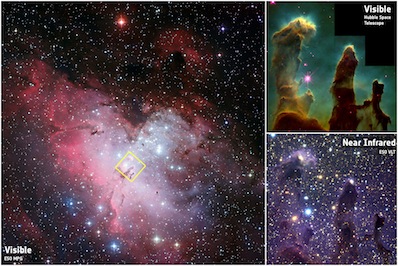



|

|

Herschel revisits
Pillars of Creation
DR EMILY BALDWIN
Astronomy Now
Posted: 18 January 2012


The European Space Agency's Herschel Space Observatory has made stunning observations of the iconic Pillars of Creation, first brought to life by the Hubble Space Telescope in 1995.
The region is part of the Eagle Nebula, or M16, a place of star birth 6,500 light years away. The iconic dust and gas pillars rise several light years above their surrounds and have been carved by the intense radiation of hot young stars near their tips.

A wide field view of the Eagle Nebula in visible light (main image) with a close-up of Hubble's iconic shot of the Pillars of Creation (top right), also presented in near infrared light by ESO's Very Large Telescope (bottom right). Image: MPG/ESO (main image); NASA/ESA/STScI (Hubble); VLT/ISAAC/AIP/ESO (near-infrared).
While Hubble is sensitive to visible light, Herschel can see in infrared, giving astronomers the ability to see through the thick dust that would otherwise obscure the view. With this capability Herschel can see inside the columns of cold gas and dust to see where dense gas is collapsing into new stars.
In Herschel's false-colour view the blue material is warm compared to its surroundings – although still below -200 degrees Celsius – with the brightest blue and white material the dense sites of new star formation. Eventually, the young stars will blow away their cocoons of surrounding material and become visible at optical wavelengths. The red regions are much colder, just a few tens of degrees above absolute zero (-273 degrees Celsius), but the bright red and orange zones show clumps of cold dust that are likely in the process of collapsing into more compact regions, eventually to ignite in new stars.

Herschel's new view of the Pillars of Creation at far infrared wavelengths (top right), and XMM-Newton's X-ray view of the central star cluster, NGC 6611 (bottom right), combined in the main image. Image: ESA/Herschel/PACS/SPIRE/HOBYS Consortium.
“These observations reveal how complicated the formation of stars is," says Professor Glenn White of the Open University and The Rutherford Appleton Laboratory. “The local environment in the Eagle Nebula is probably very similar to that when our own Solar System when formed almost 5 billion years ago - so seeing these images is a bit like using a time machine to look at how our own Solar System must have been born. In the Eagle Nebula we are observing the formation of individual stars, as well as seeing the way that that radiation from an earlier generation of stars formed several million years previously can induce new star formation in nearby material in the Galaxy”.
To complement Herschel's far infrared view, X-ray observations from ESA's XMM-Newton spacecraft, and optical and near-infrared observations from ESO's ground-based Very Large Telescope, as well as Hubble, provide a multi-wavelength view of the star-formation region, revealing also the locations of hot young stars in the central star cluster, NGC 6611, responsible for eroding away the pillars. Astronomers suspect that one of the cluster's more massive stars may have already exhausted its fuel supply and exploded in a fiery supernova event, contributing to the destruction of the pillars.
|

|

|

|
|



